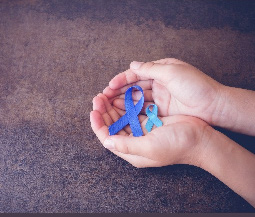The month of March is dedicated to colorectal cancer, otherwise known as colon cancer. This month is meant to spread awareness about the seriousness of colon cancer, as it is the third most common cancer diagnosed in the United States, according to Health Finder.
The awareness’ main goal is to encourage people to get screened regularly to detect it early. This cancer mostly affects people the age of 50 or older; so, it is recommended to begin getting screened at this age, unless there is a history of this specific cancer in one’s family. If a person has a family history of colorectal cancer, it is recommended to get screened early, as they can be more predisposed to cancer.
Cheryl Kozina, assistant professor of Biology, said, “In my dad’s family, he had an uncle who had an ostomy bag for most of his life because he had had his colon removed as a precautionary measure when they found cancer. There was lots of chemo, and he lost a lot of weight. It’s hard to get back to a normal routine; but, since treatments have ended, he has been getting back into daily kind of things.”
She also mentions that her father underwent many screenings due to the history of cancer in the family; to make sure if he were to develop the cancer, it would be caught early on.
Health Finder also mentions that colon cancer is the second highest cause of death in the world of cancer.
Colorectal cancer symptoms are broken down into two categories of local and systematic, states Cancer Center.
Colon cancer directs symptoms in the colon and or rectum. Common symptoms people experience are changes in bowel habits, such as constipation and diarrhea. Other symptoms include rectal bleeding, and abdominal bloating/cramps. These symptoms will appear for an extended period, and these are symptoms of cancer that affect only the colon, which are indicative of local colorectal cancer.
There is another type called systemic colorectal cancer, which affects the entire body. Common symptoms include unexplained weight loss, loss of appetite, chronic weakness/ fatigue, and nausea/ vomiting.
Health Line states, no two diagnoses will be the same because of the complexity of the cancer, and this also applies to one’s life expectancy. The survival statistics used are supposed to be used as a guide, meaning it will not be accurate for everyone.
“Every colon cancer is different and depending if you get radiation or get chemo, every treatment will have its own side effects. There can be weight loss, hair loss and surgeries involved. Every treatment will come with its own tolls; so, someone who has colon cancer might have to have surgical removal of not just the polyps but maybe even the colon entirely, which can result in physical issues of evacuating your bowel,” mentioned Kozina.
There are several different ways that the survival rates are broken down: localized, regional, distant and unknown stage. They all use the five-year survival rate, which is the percentage of people who are still alive after five years of being diagnosed with cancer.
The localized survival rate is when the cancer has not spread past the original diagnosed area, most likely being the colon. This is usually within 0 to 1 stage colon cancer, and people who are at this stage has an 89.9 percent five-year survival rate.
Regional cancer is when the cancer has spread throughout to close lymph nodes. There is about a 71.3 percent five-year survival rate at this stage.
Distant cancer is when the cancer has spread to other areas of the body. These can be areas, such as the lungs, brain or liver. There is a 13.9 percent chance of a five-year survival rate.
The last one is known as the unknown stage. At this point, the cancer may be at any given stage, but it is unknown due to the patient deciding not to have any more treatment/testing done. The five-year survival rate for the unknown stage is about 35.4 percent.
In 2017, there were about 135,430 new cases of colorectal cancer in the United States. There were also about 50,260 deaths due to the cancer, according to National Cancer Institute.
Rates of cancer have been rising over the years; however, these sudden increases in numbers may have to do with the fact that science is improving. Science in the medical field is always developing, aiding medical physicians in recognizing specific diseases earlier than what they have been able to in the past.
“I know we’re getting better at diagnosing it [colon cancer]because of better screenings. But, unfortunately that equates to having more instances of the disease. So, the better we get at diagnosing it and detecting it early, it sometimes seems that the rate of the disease is going up when actually we are just getting better at finding it. So, there are pros and cons of things like colonoscopies which is that it looks like we have more of the disease but were just getting better at catching it early,” Kozina adds about high diagnosis rates.
National Cancer Institute statistics show that African-Americans have a higher rate than any other race/ethnicity. Other races, such as white and American Indian/ Alaska Native, are very close behind.
The National Cancer Institute’s statistics also show that the age group most affected is 65 to 74.
World Cancer Research Fund International writes that two-thirds of the diagnoses of the cancer are in highly developed countries; they ranked the top 20 countries with the most diagnoses.





